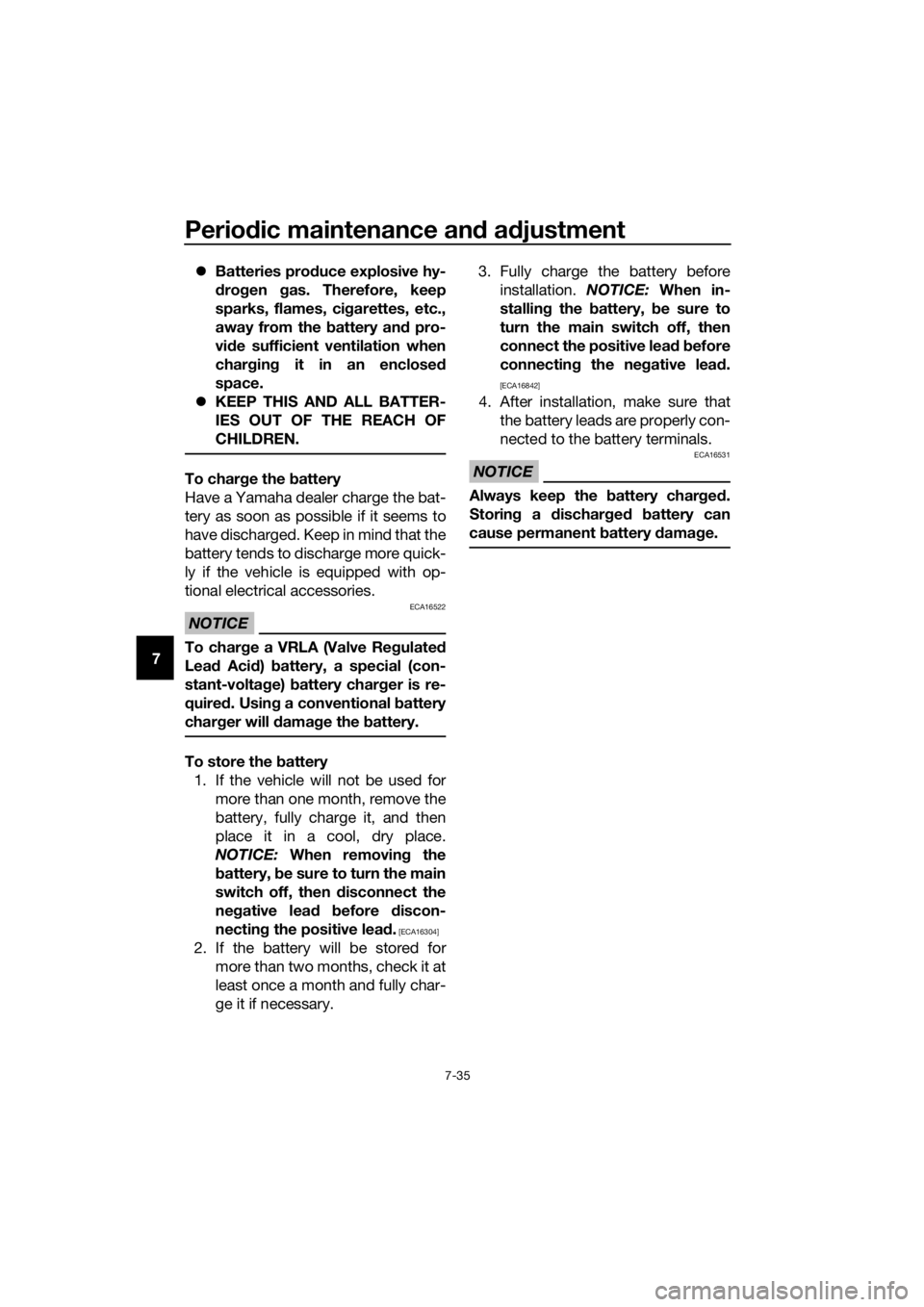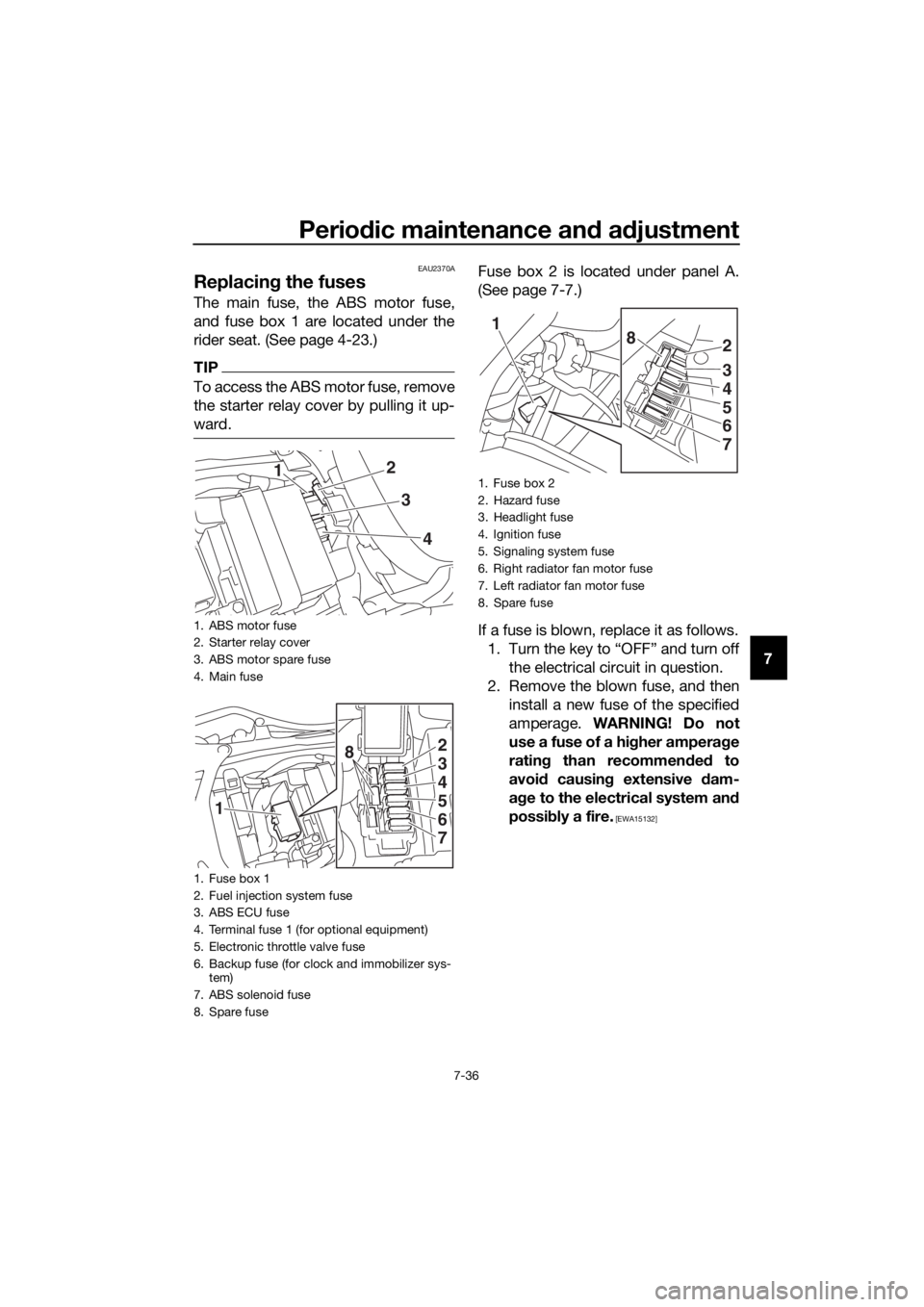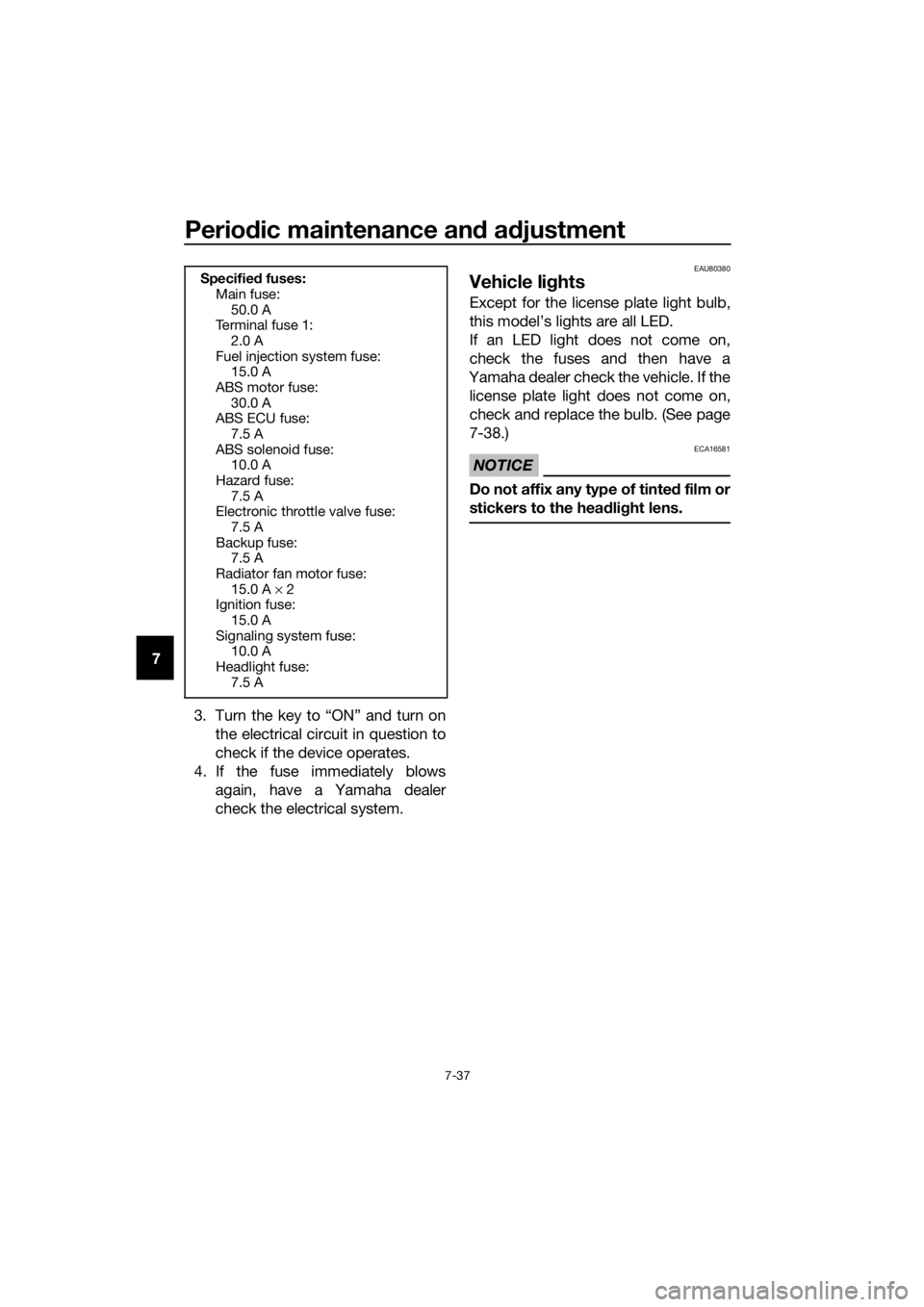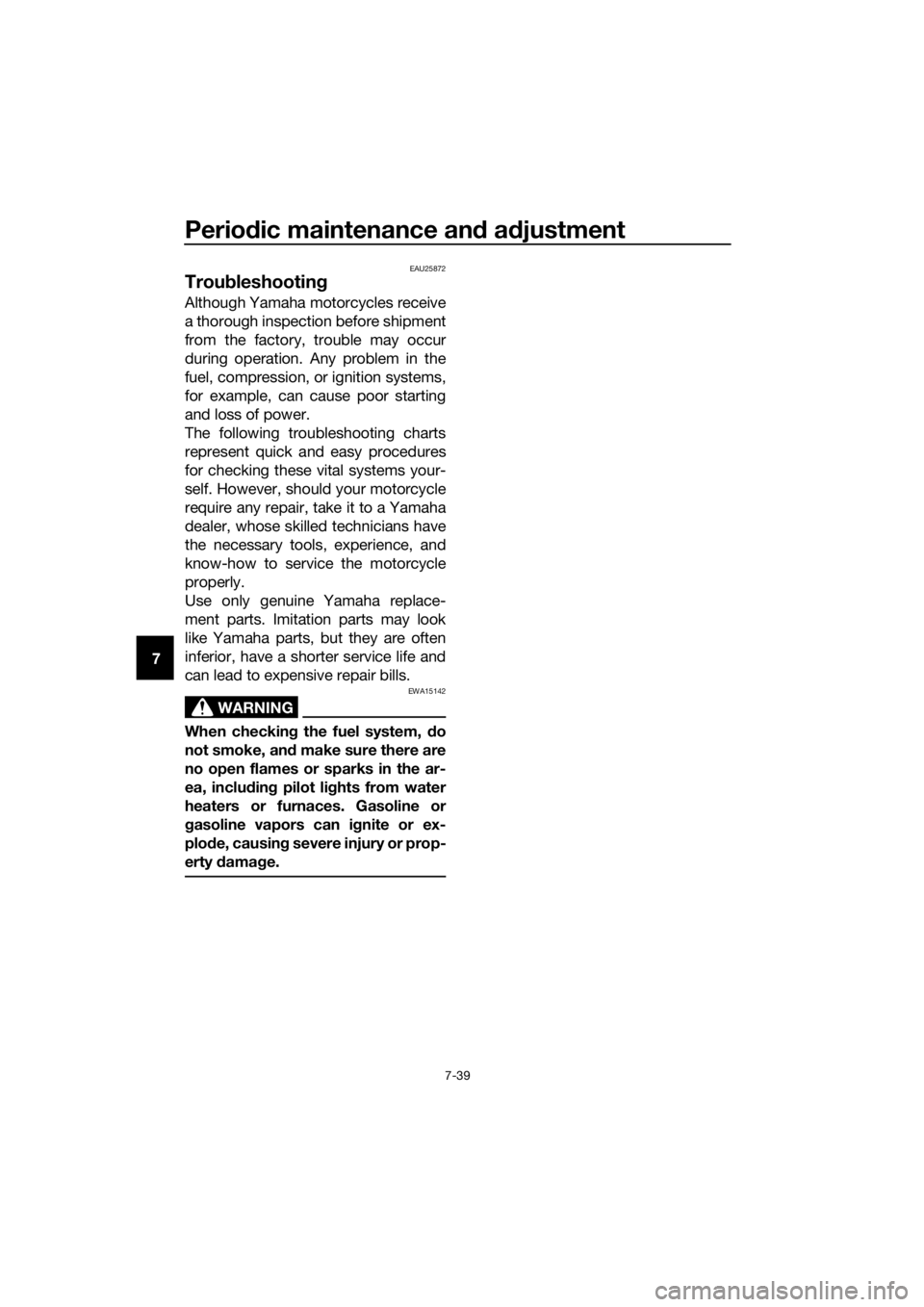YAMAHA YZF-R6 2018 Owners Manual
Manufacturer: YAMAHA, Model Year: 2018, Model line: YZF-R6, Model: YAMAHA YZF-R6 2018Pages: 114, PDF Size: 4.36 MB
Page 91 of 114

Periodic maintenance an d a djustment
7-34
7
EAU23292
Checkin g the wheel b earings
The front and rear wheel bearings must
be checked at the intervals specified in
the periodic maintenance and lubrica-
tion chart. If there is play in the wheel
hub or if the wheel does not turn
smoothly, have a Yamaha dealer
check the wheel bearings.
EAU50212
Battery
The battery is located under the rider
seat. (See page 4-23.)
This model is equipped with a VRLA
(Valve Regulated Lead Acid) battery.
There is no need to check the electro-
lyte or to add distilled water. However,
the battery lead connections need to
be checked and, if necessary, tight-
ened.
WARNING
EWA10761
Electrolyte is poisonous an d
d an gerous since it contains sul-
furic aci d, which causes severe
b urns. Avoi d any contact with
skin, eyes or clothin g an d al-
ways shiel d your eyes when
workin g near b atteries. In case
of contact, ad minister the fol-
lowin g FIRST AID.
EXTERNAL: Flush with plenty of water.
INTERNAL: Drink lar ge quan-
tities of water or milk an d im-
me diately call a physician.
EYES: Flush with water for 15 minutes and seek prompt
me dical attention.
1. Battery
2. Positive battery lead (red)
3. Negative battery lead (black)
1
3
2
UBN6E1E0.book Page 34 Thursday, October 5, 2017 2:48 PM
Page 92 of 114

Periodic maintenance an d a djustment
7-35
7
Batteries pro duce explosive hy-
d ro gen gas. Therefore, keep
sparks, flames, ci garettes, etc.,
away from the battery an d pro-
vi de sufficient ventilation when
char gin g it in an enclose d
space.
KEEP THIS AND ALL BATTER-
IES OUT OF THE REACH OF
CHILDREN.
To char ge the battery
Have a Yamaha dealer charge the bat-
tery as soon as possible if it seems to
have discharged. Keep in mind that the
battery tends to discharge more quick-
ly if the vehicle is equipped with op-
tional electrical accessories.
NOTICE
ECA16522
To char ge a VRLA (Valve Re gulate d
Lea d Aci d) battery, a special (con-
stant-volta ge) battery char ger is re-
quire d. Using a conventional battery
char ger will dama ge the b attery.
To store the battery
1. If the vehicle will not be used for more than one month, remove the
battery, fully charge it, and then
place it in a cool, dry place.
NOTICE: When removin g the
b attery, be sure to turn the main
switch off, then disconnect the
ne gative lea d before discon-
nectin g the positive lea d.
[ECA16304]
2. If the battery will be stored for
more than two months, check it at
least once a month and fully char-
ge it if necessary. 3. Fully charge the battery before
installation. NOTICE: When in-
stallin g the b attery, be sure to
turn the main switch off, then
connect the positive lead b efore
connectin g the ne gative lea d.
[ECA16842]
4. After installation, make sure that
the battery leads are properly con-
nected to the battery terminals.
NOTICE
ECA16531
Always keep the b attery charged .
Storin g a d ischar ged battery can
cause permanent b attery damag e.
UBN6E1E0.book Page 35 Thursday, October 5, 2017 2:48 PM
Page 93 of 114

Periodic maintenance an d a djustment
7-36
7
EAU2370A
Replacin g the fuses
The main fuse, the ABS motor fuse,
and fuse box 1 are located under the
rider seat. (See page 4-23.)
TIP
To access the ABS motor fuse, remove
the starter relay cover by pulling it up-
ward.
Fuse box 2 is located under panel A.
(See page 7-7.)
If a fuse is blown, replace it as follows.
1. Turn the key to “OFF” and turn off the electrical circuit in question.
2. Remove the blown fuse, and then install a new fuse of the specified
amperage. WARNING! Do not
use a fuse of a hi gher ampera ge
ratin g than recommen ded to
avoi d causin g extensive dam-
a g e to the electrical system an d
possi bly a fire.
[EWA15132]
1. ABS motor fuse
2. Starter relay cover
3. ABS motor spare fuse
4. Main fuse
1. Fuse box 1
2. Fuel injection system fuse
3. ABS ECU fuse
4. Terminal fuse 1 (for optional equipment)
5. Electronic throttle valve fuse
6. Backup fuse (for clock and immobilizer sys-
tem)
7. ABS solenoid fuse
8. Spare fuse
2
3
4
1
2
1
3
4
5
8
6
7
1. Fuse box 2
2. Hazard fuse
3. Headlight fuse
4. Ignition fuse
5. Signaling system fuse
6. Right radiator fan motor fuse
7. Left radiator fan motor fuse
8. Spare fuse
2
1
3
4
5
8
6
7
UBN6E1E0.book Page 36 Thursday, October 5, 2017 2:48 PM
Page 94 of 114

Periodic maintenance an d a djustment
7-37
7
3. Turn the key to “ON” and turn onthe electrical circuit in question to
check if the device operates.
4. If the fuse immediately blows again, have a Yamaha dealer
check the electrical system.
EAU80380
Vehicle li ghts
Except for the license plate light bulb,
this model’s lights are all LED.
If an LED light does not come on,
check the fuses and then have a
Yamaha dealer check the vehicle. If the license plate light does not come on,
check and replace the bulb. (See page
7-38.)
NOTICE
ECA16581
Do not affix any type of tinted film or
stickers to the head light lens.
Specifie d fuses:
Main fuse: 50.0 A
Te r m i n a l f u s e 1 :
2.0 A
Fuel injection system fuse: 15.0 A
ABS motor fuse: 30.0 A
ABS ECU fuse:
7.5 A
ABS solenoid fuse: 10.0 A
Hazard fuse: 7.5 A
Electronic throttle valve fuse:
7.5 A
Backup fuse: 7.5 A
Radiator fan motor fuse: 15.0 A × 2
Ignition fuse:
15.0 A
Signaling system fuse: 10.0 A
Headlight fuse: 7.5 A
UBN6E1E0.book Page 37 Thursday, October 5, 2017 2:48 PM
Page 95 of 114

Periodic maintenance an d a djustment
7-38
7
EAU24314
Replacin g the license plate
li g ht bul b
1. Remove the license plate light unit
by removing the screws.
2. Remove the license plate light bulb socket (together with the
bulb) by pulling it out.
3. Remove the burnt-out bulb by pulling it out.
4. Insert a new bulb into the socket.
5. Install the socket (together with the bulb) by pushing it in.
6. Install the license plate light unit by installing the screws.
EAU67131
Supportin g the motorcycle
Since this model is not equipped with a
centerstand, use maintenance stands
when removing the front or rear wheel
or when performing other maintenance
that requires the motorcycle to stand
up right.
Check that the motorcycle is in a stable
and level position before starting any
maintenance.
1. License plate light unit
2. Screw
1. License plate light bulb socket
2. License plate light bulb
1
2
12
1. Maintenance stand (example)
1
UBN6E1E0.book Page 38 Thursday, October 5, 2017 2:48 PM
Page 96 of 114

Periodic maintenance an d a djustment
7-39
7
EAU25872
Trou bleshootin g
Although Yamaha motorcycles receive
a thorough inspection before shipment
from the factory, trouble may occur
during operation. Any problem in the
fuel, compression, or ignition systems,
for example, can cause poor starting
and loss of power.
The following troubleshooting charts
represent quick and easy procedures
for checking these vital systems your-
self. However, should your motorcycle
require any repair, take it to a Yamaha
dealer, whose skilled technicians have
the necessary tools, experience, and
know-how to service the motorcycle
properly.
Use only genuine Yamaha replace-
ment parts. Imitation parts may look
like Yamaha parts, but they are often
inferior, have a shorter service life and
can lead to expensive repair bills.
WARNING
EWA15142
When checkin g the fuel system, do
not smoke, an d make sure there are
no open flames or sparks in the ar-
ea, inclu din g pilot lig hts from water
heaters or furnaces. Gasoline or
g asoline vapors can i gnite or ex-
plod e, causin g severe injury or prop-
erty damag e.
UBN6E1E0.book Page 39 Thursday, October 5, 2017 2:48 PM
Page 97 of 114

Periodic maintenance an d a djustment
7-40
7
EAU63470
Trou bleshootin g charts
Startin g pro blems or poor en gine performance
1. FuelThere is enough fuel.
There is no fuel.
Check the battery.
Supply fuel.
The engine turns over
quickly.
The engine turns over
slowly.
The engine does not
start.
Check the battery.
Wipe off with a dry
cloth and correct the
spark plug gaps, or
replace the spark
plugs.
Check the battery
lead connections, and
have a Yamaha dealer
charge the battery if
necessary.
2. BatteryThe battery is good.
The engine does not
start.
Check the ignition.
3. IgnitionWetOperate the electric
starter.
Dry
There is compression.
There is no
compression.
The engine does not start.
Have a Yamaha dealer check the vehicle.
Have a Yamaha dealer check the vehicle.
The engine does not
start.
Check the
compression.Have a Yamaha
dealer check the
vehicle.
Remove the spark
plugs and check
the electrodes.
Operate the electric
starter.
Operate the electric
starter.
Check the fuel level
in the fuel tank.
4. Compression
UBN6E1E0.book Page 40 Thursday, October 5, 2017 2:48 PM
Page 98 of 114

Periodic maintenance an d a djustment
7-41
7 En
gine overheatin g
WARNING
EWAT1041
Do not remove the ra diator cap when the en gine an d ra diator are hot.
Scal din g hot flui d an d steam may b e blown out un der pressure, which
coul d cause serious injury. Be sure to wait until the eng ine has cooled.
Place a thick ra g, like a towel, over the ra diator cap, an d then slowly ro-
tate the cap counterclockwise to the detent to allow any resi dual pres-
sure to escape. When the hissin g soun d has stopped , press down on the
cap while turnin g it counterclockwise, an d then remove the cap.
TIP
If coolant is not available, tap water can be temporarily used instead, provided
that it is changed to the recommended coolant as soon as possible.
Wait until the engine
has cooled.
Check the coolant
level in the reservoir
and radiator.Add coolant.
(See TIP.)
The coolant level is
OK.
There is no leakage.
There is leakage.
The coolant level is
low.
Check the cooling
system for leakage.
Have a Yamaha
dealer check and
repair the cooling
system.
Start the engine. If the engine overheats again,
have a Yamaha dealer check and repair the cooling
system.
UBN6E1E0.book Page 41 Thursday, October 5, 2017 2:48 PM
Page 99 of 114

Motorcycle care and stora ge
8-1
8
EAU37834
Matte color caution
NOTICE
ECA15193
Some mo dels are equipped with
matte colored finished parts. Be
sure to consult a Yamaha dealer for
a d vice on what pro ducts to use be-
fore cleanin g the vehicle. Usin g a
b rush, harsh chemical prod ucts or
cleanin g compoun ds when cleanin g
these parts will scratch or damag e
their surface. Wax also shoul d not
b e applie d to any matte colored fin-
ishe d parts.
EAU54721
Care
While the open design of a motorcycle
reveals the attractiveness of the tech-
nology, it also makes it more vulnera-
ble. Rust and corrosion can develop
even if high-quality components are
used. A rusty exhaust pipe may go un-
noticed on a car, however, it detracts
from the overall appearance of a mo-
torcycle. Frequent and proper care
does not only comply with the terms of
the warranty, but it will also keep your
motorcycle looking good, extend its
life and optimize its performance.
Before cleanin g
1. Cover the muffler outlet with a plastic bag after the engine has
cooled down.
2. Make sure that all caps and cov- ers as well as all electrical cou-
plers and connectors, including
the spark plug caps, are tightly in-
stalled.
3. Remove extremely stubborn dirt, like oil burnt onto the crankcase,
with a degreasing agent and a
brush, but never apply such prod-
ucts onto seals, gaskets, sprock-
ets, the drive chain and wheel
axles. Always rinse the dirt and
degreaser off with water.
Cleanin g
NOTICE
ECA11143
Avoi d using strong aci dic wheel
cleaners, especially on spoked
wheels. If such pro ducts are
use d on har d-to-remove dirt, do
not leave the cleaner on the af-
UBN6E1E0.book Page 1 Thursday, October 5, 2017 2:48 PM
Page 100 of 114

Motorcycle care and stora ge
8-2
8 fected
area any lon ger than in-
structe d. Also, thorou ghly rinse
the area off with water, imme di-
ately dry it, an d then apply a cor-
rosion protection spray.
Improper cleanin g can d amage
plastic parts (such as cowlin gs,
panels, win dshield s, hea dlig ht
lenses, meter lenses, etc.) an d
the mufflers. Use only a soft,
clean cloth or spon ge with wa-
ter to clean plastic. However, if
the plastic parts cannot be thor-
ou ghly cleaned with water, di-
lute d mil d d eter gent with water
may be used . Be sure to rinse
off any d etergent resi due usin g
plenty of water, as it is harmful
to plastic parts.
Do not use any harsh chemical
prod ucts on plastic parts or the
muffler. Be sure to avoi d usin g
cloths or spon ges which have
b een in contact with stron g or
a b rasive cleanin g prod ucts, sol-
vent or thinner, fuel ( gasol
ine),
rust removers or inhi bitors,
b rake flui d, antifreeze or elec-
trolyte.
Do not use hi gh-pressure wash-
ers or steam-jet cleaners since
they cause water seepa ge an d
d eterioration in the followin g ar-
eas: seals (of wheel an d swin g-
arm bearin gs, fork an d b rakes),
stora ge compartments, electric
components (couplers, connec-
tors, instruments, switches an d
li g hts), breather hoses an d
vents.
For motorcycles equippe d with
a win dshiel d: Do not use stron g
cleaners or har d spon ges as
they will cause dullin g or
scratching . Some cleanin g
compoun ds for plastic may
leave scratches on the win d-
shield . Test the pro duct on a
small hi dden part of the win d-
shield to make sure that it d oes
not leave any marks. If the win d-
shield is scratche d
, use a quality
plast
ic polishin g compoun d af-
ter washin g.
After normal use
Remove dirt with warm water, a mild
detergent, and a soft, clean sponge,
and then rinse thoroughly with clean
water. Use a toothbrush or bottlebrush
for hard-to-reach areas. Stubborn dirt
and insects will come off more easily if
the area is covered with a wet cloth for
a few minutes before cleaning.
After riding in the rain, near the sea or
on salt-sprayed roads
Since sea salt or salt sprayed on roads
during winter are extremely corrosive
in combination with water, carry out
the following steps after each ride in
the rain, near the sea or on salt-
sprayed roads.
TIP
Salt sprayed on roads in the winter
may remain well into spring.
1. Clean the motorcycle with cold
water and a mild detergent, after
the engine has cooled down.
UBN6E1E0.book Page 2 Thursday, October 5, 2017 2:48 PM